Frost Protection - UTL Repository
Frost Protection - UTL Repository
Frost Protection - UTL Repository
Create successful ePaper yourself
Turn your PDF publications into a flip-book with our unique Google optimized e-Paper software.
]<br />
F R O S T P R O T E C T I O N : F U N D A M E N T A L S , P R A C T I C E A N D E C O N O M I C S<br />
[<br />
there is no known research on the topic, another possibility might be to fog or<br />
mist the air rather than use sprinklers. This could cool the air without adding<br />
water to the soil. However, this may or may not be cost effective depending on<br />
the frequency and intensity of freezing in the area.<br />
CHEMICALS TO DELAY BLOOM<br />
Cryoprotectants and antitranspirants are sold and used as protection against<br />
frost damage. However, none of these materials has been found to consistently<br />
give protection to flower buds, flowers, small fruits or small nuts. The ethylenereleasing<br />
growth regulator “Ethephon” increases bud hardiness and delays<br />
flowering 4 to 7 days if applied in the early autumn at the onset of chilling<br />
(Powell and Himelrick, 2000). It has been used on peaches and cherries.<br />
Gibberellic acid delays bloom of some crops, but multiple applications are<br />
needed and it is expensive. Gibberellin or alpha naphthaleneacetic acid<br />
applications during warm days in late winter and spring are known to delay leaf<br />
out (Nigond, 1960; Schultz and Weaver, 1977).<br />
Using growth regulators to reduce cambial activity and lengthen dormancy helps<br />
both evergreens and deciduous trees to tolerate subzero temperature. It is generally<br />
accepted that a retardation of growth reduces cell elongation. And the smaller cells<br />
have higher concentrations of solutes, which help them to avoid freezing.<br />
PLANT COVERS<br />
Plant row covers increase downward long-wave radiation at night and reduce<br />
losses of heat to the air by heat convection (and advection). Covers must have a<br />
low coefficient of conduction and ideally would be opaque to long-wave<br />
radiation. Dry soil has a lower thermal conductivity, so it is sometimes used to<br />
cover small plants (e.g. potato, tomato and coffee plants) or to protect trunks of<br />
young trees during relatively short subzero periods. In some countries with<br />
severe winters, soil is mounded up to cover the graft of young citrus to protect<br />
the trunks from frosts (Blanc et al. 1963).<br />
Removable straw coverings are used extensively in Switzerland for frost<br />
protection of the grapevines. However, because of easier application, straw is<br />
being replaced with synthetic materials. Both types of covers are left on the<br />
plants until the danger of the freezing is gone (Peyer, 1965). Mats and other<br />
insulating materials have also been used in India to protect tea (Camellia sinensis)<br />
plants from freezing (Von Legerke, 1978). In Portugal, individual plant<br />
protection methods include (1) horizontal or inclined mats for young trees;<br />
(2) shelters of diverse form for small plantings of citrus or garden shrubs; (3) wraps<br />
130


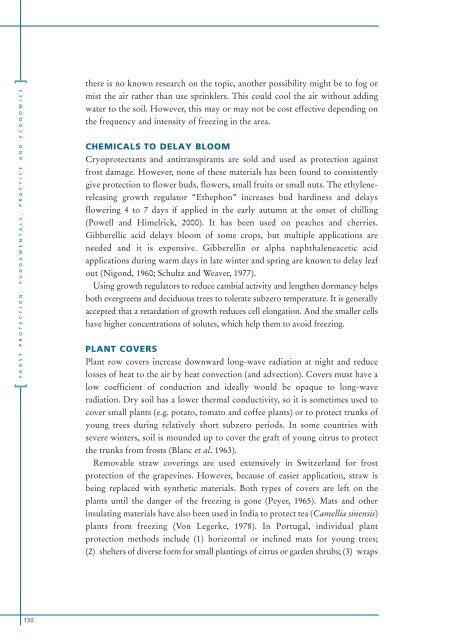
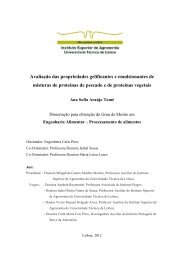
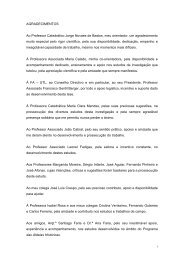

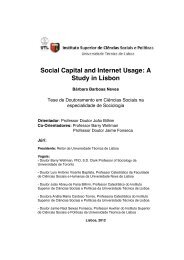
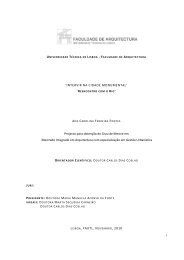
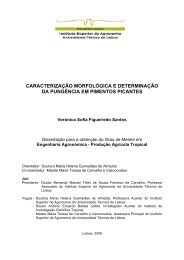

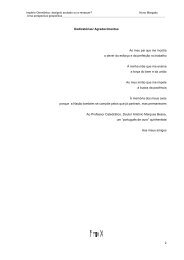
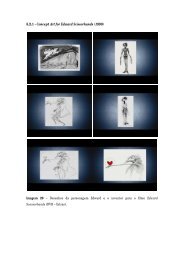
![Tese - Es..[1].pdf - UTL Repository - Universidade Técnica de Lisboa](https://img.yumpu.com/25707135/1/184x260/tese-es1pdf-utl-repository-universidade-taccnica-de-lisboa.jpg?quality=85)


